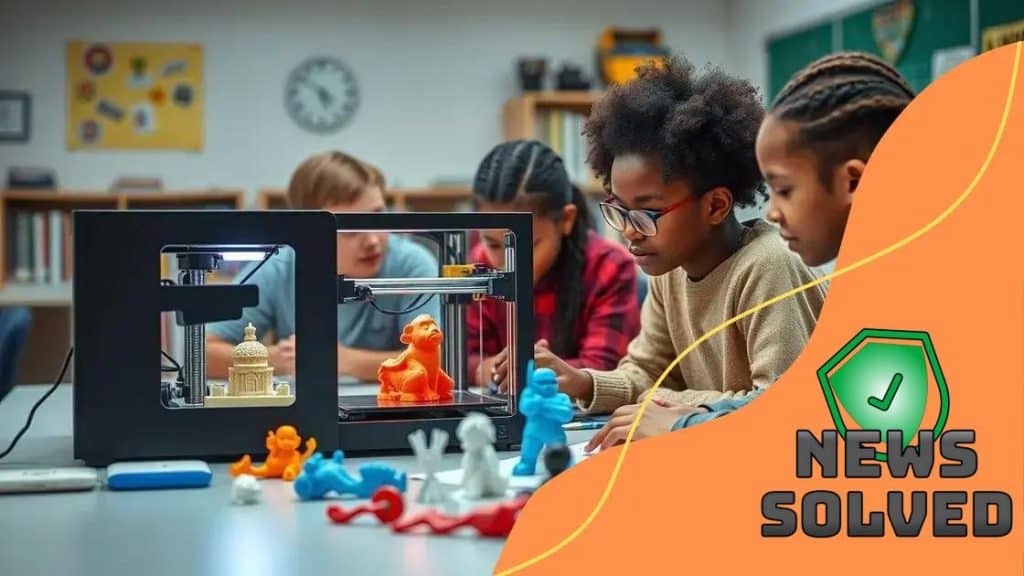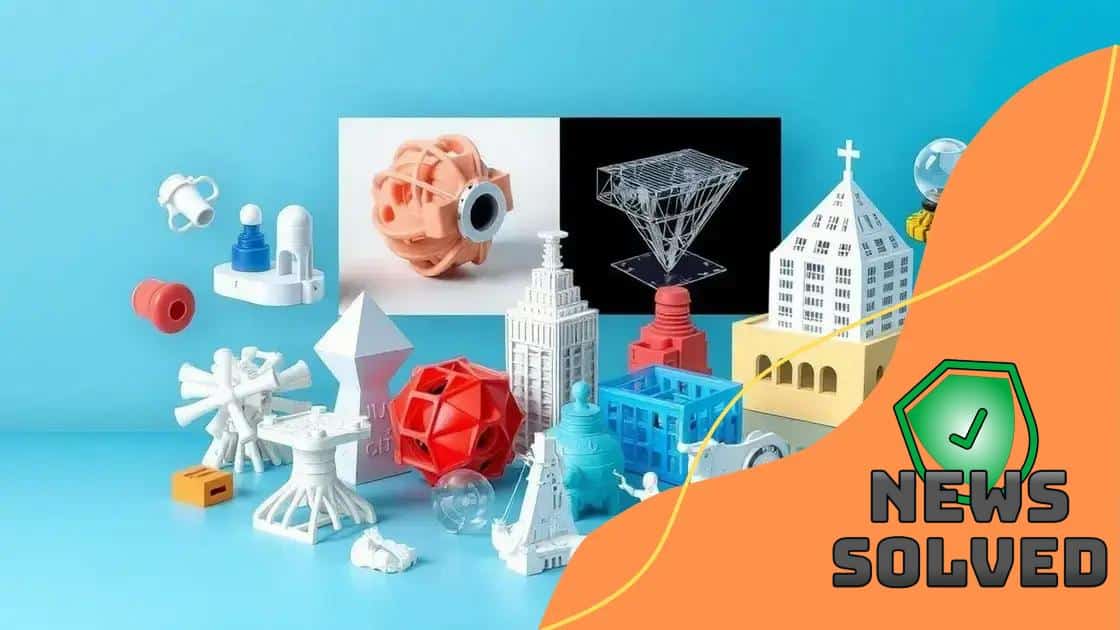The role of 3D printing in educational environments

Advertisements
The role of 3D printing in educational environments enhances hands-on learning, fosters creativity, and encourages collaboration, making it a transformative tool for preparing students for future careers.
The role of 3D printing in educational environments is becoming increasingly significant. Have you ever imagined how students can bring their ideas to life through technology? This article will dive into its impact on learning.
Advertisements
Understanding the basics of 3D printing
Understanding the basics of 3D printing is crucial in today’s educational landscape. This technology allows teachers and students to create physical objects from digital models, fostering a hands-on learning environment.
At its core, 3D printing involves layering materials to build a three-dimensional object. The process can be used in various subjects, from science to art, encouraging creativity and innovation.
The 3D Printing Process
The basic steps in 3D printing include:
Advertisements
- Designing a model using CAD software.
- Converting the model into a printable format.
- Using a printer to create the object layer by layer.
Each step is vital to ensure the final product is accurate and functional. As students navigate this process, they learn valuable skills in technology and engineering.
Applications in Education
The applications of 3D printing in education are vast. For example, science students can create anatomical models, while art classes can develop sculptures. This functionality promotes collaborative learning and sparks interest in fields like design and architecture.
Moreover, the ability to make prototypes enables students to test their ideas in real-time. This hands-on approach not only reinforces theoretical concepts but also builds problem-solving skills.
Furthermore, incorporating 3D printing into the curriculum enhances student engagement. It transforms traditional learning methods into interactive experiences, making the learning process more enjoyable and impactful.
Benefits of 3D printing in classrooms
Exploring the benefits of 3D printing in classrooms reveals an exciting shift in how students learn and engage with their education. This technology opens doors to immersive experiences that challenge traditional teaching methods.
One significant advantage is the promotion of creativity. With 3D printing, students can turn their ideas into tangible objects, enhancing their understanding of complex concepts. This hands-on approach encourages innovation and problem-solving.
Enhanced Learning Opportunities
The use of 3D printing in classrooms creates enhanced learning opportunities across various subjects. For example:
- In science, students can create models of the solar system or human anatomy.
- Art classes benefit from opportunities to design and print sculptures.
- Math students can visualize geometric concepts with physical models.
Each subject area becomes more engaging, fostering a deeper connection to the material. Students actively participate in their learning, rather than passively receiving information.
Collaboration and Teamwork
Another notable benefit is the encouragement of collaboration and teamwork. Students often work in groups to create their designs, which fosters communication and cooperation. This experience builds essential skills that are valuable in the workforce.
As they navigate the design and printing process, students discuss ideas, offer suggestions, and learn from each other. The collaborative environment helps students bond and enhances their social skills, making learning not just about individual achievement but about working together towards a common goal.
Additionally, the accessibility of 3D printing technology allows for individualized learning. Teachers can provide tailored projects to meet students’ diverse needs, ensuring that every learner can engage effectively.
Innovative applications of 3D printing

Innovative applications of 3D printing are transforming industries and educational environments alike. This technology enables unique solutions that were not possible with traditional manufacturing methods. By creating objects layer by layer, 3D printing provides freedom in design and functionality.
One exciting application is in the field of medicine. Hospitals and clinics are using 3D printing to create custom prosthetics and implants tailored to individual patients. This personalization not only improves patient outcomes but also reduces production costs and time.
Architecture and Construction
In architecture, 3D printing allows for the rapid creation of complex models. Builders can visualize their designs more effectively, which aids in planning and decision-making. Additionally, some companies are exploring 3D printing for constructing entire buildings. This method can significantly lower construction waste and speed up the building process.
- Prototypes for product development can be produced quickly, allowing for frequent testing and feedback.
- Educational tools and resources can be developed on-demand, making learning materials readily available.
- Art and design projects can benefit from intricate and precise creations that push the boundaries of creativity.
The potential of 3D printing extends to aerospace as well. Engineers can produce lightweight and complex parts that enhance efficiency and performance. The ability to create parts on-site also reduces logistical challenges and costs.
As technology continues to evolve, other industries are also finding new ways to incorporate 3D printing into their processes. From fashion to food production, the innovative uses are truly limitless, demonstrating how this technology is reshaping our world.
Challenges of integrating 3D printing in education
Integrating 3D printing in education comes with its set of challenges. While this technology offers numerous benefits, schools face obstacles that can hinder its effective use. Understanding these challenges is essential for successful implementation.
One primary issue is the cost of 3D printing equipment and materials. Schools must invest in printers, software, and filaments, which can strain budgets. Additionally, maintenance of this equipment can add further expenses, creating a barrier for many institutions.
Training and Skill Development
Teachers need proper training to utilize 3D printing effectively in their classrooms. Many educators may not be familiar with the technology, resulting in a steep learning curve. Professional development opportunities are crucial to ensure that teachers feel confident and competent in incorporating this technology into their lessons.
Moreover, students require guidance on 3D design software. While some are quick learners, others may struggle, so providing adequate support is vital. This guidance helps all students engage with the technology meaningfully.
Curriculum Integration
Another significant challenge is integrating 3D printing into the existing curriculum. It can be difficult to find ways to incorporate this technology across various subjects. Some educators may be unsure how to align 3D printing projects with learning objectives and standards.
- Finding relevant projects that enhance learning can be time-consuming.
- Creating cross-disciplinary projects takes planning and collaboration among teachers.
- Understanding local education policies regarding technology use can be complex.
Additionally, schools need to ensure they have reliable access to the necessary software. Without proper digital tools, the benefits of 3D printing can be diminished. Schools must address these technology gaps to provide effective learning environments.
Lastly, there are safety concerns surrounding the use of 3D printing. Teachers must ensure students follow safety guidelines when operating printers. Understanding potential hazards, like the heat of the printer or fumes from certain materials, is essential for maintaining a safe classroom environment.
Future trends of 3D printing in education
Future trends of 3D printing in education are setting the stage for remarkable improvements in teaching and learning processes. As technology continues to evolve, educators are discovering new and innovative ways to integrate 3D printing into their classrooms.
One major trend is the increased accessibility of 3D printing technology. As prices for printers and materials decrease, more schools will be able to afford these tools. This growth enables a wider range of students to participate in hands-on learning experiences, making 3D printing an integral part of curricula at all educational levels.
Enhanced Software Tools
Another trend involves the development of more user-friendly software. As design programs become easier to use, students will find it simpler to create their digital models. Schools are likely to adopt tools that offer tutorials and resources tailored for young learners, promoting creativity and innovation.
Integrating these software solutions into education will empower students to develop skills in design and engineering from an early age. This focus on preparing students for future careers in STEM fields is becoming increasingly important in today’s job market.
Collaboration Across Disciplines
Future trends also indicate a rise in collaboration between different subject areas. 3D printing is uniquely suited to support interdisciplinary projects where students can apply concepts from science, art, and math together. For example, in a joint project between math and art classes, students could design complex geometric sculptures with 3D printing technology.
- Such projects enhance critical thinking and problem-solving skills.
- Students learn to communicate across disciplines, fostering teamwork.
- Real-world applications become more engaged, making education relevant.
The potential for community partnerships is another exciting trend. Schools can collaborate with local businesses and organizations to gain access to advanced 3D printing resources and expertise. These partnerships can provide students with mentorship opportunities and insights into various industries.
Lastly, the future of 3D printing in education may include advancements in materials. As more sustainable filaments become available, students will learn about environmental responsibility while using technology, connecting their projects to real-world issues.
FAQ – Frequently Asked Questions about 3D Printing in Education
What are the primary benefits of using 3D printing in classrooms?
3D printing enhances hands-on learning, promotes creativity, and encourages collaboration among students.
Are there any challenges in integrating 3D printing into education?
Yes, challenges include costs, the need for proper training for educators, and difficulties in curriculum integration.
How can 3D printing prepare students for future careers?
It provides students with valuable skills in design, engineering, and technology that are essential in today’s job market.
What are some innovative applications of 3D printing in schools?
3D printing is used for creating custom educational tools, engaging projects across various subjects, and prototyping ideas.





